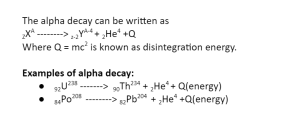The French physicist Henry Becquerel discovered the phenomenon of radioactivity in 1896. He observed that few invisible rays are spontaneously emitted from the uranium and its compounds, which can penetrate the black paper and silver. These rays are also able to affect the photographic plate wrapped in paper. These rays were named becquerel rays. The substances which emit these rays are called radioactive substances, and the phenomenon of spontaneous emission of these rays is called radioactivity.
The same phenomenon was confirmed in 1898 by Pierre and Marie Curie. The Curie couple showed that uranium ores contain traces of polonium (Po) and radium (Ra), and these two elements were much more radioactive than uranium.
There are about 40 radioactive elements – e.g., radon, thorium, etc. The natural elements whose atomic number is greater than 82 are unstable, and thus, they are radioactive.
Radioactive Decay Law
Based on the study of radioactive substances, Rutherford and Soddy propounded a law called Rutherford-Soddy’s rule or radioactive decay law. According to this law, “The number of nuclei disintegrating per second of a radioactive sample at any instant is directly proportional to the number of nuclei present in the sample at that instant.”
Cause of radioactivity: The instability of heavier nuclei is the cause of radioactivity for the nuclei having mass numbers greater than 140, i.e., the binding energy per nucleon goes on decreasing. Heavy nuclei have a large number of protons. The repulsion between the protons merely affects the nuclear force between them, and hence heavy nuclei show instability.
Properties of Becquerel Rays
These rays are emitted from all the compounds of a radioactive substance.
There is no effect of the substance’s temperature or physical and chemical states in these rays.
Becquerel rays are composed of alpha particles (α), beta particles (β), and gamma rays (γ).
Nature of Becquerel Rays
Lord Rutherford and his associates investigated the nature of becquerel rays. The narrow beam of these rays subjected to an electric or magnetic field splits into three components. Few rays bend towards the negatively charged plate. These rays have a positive charge and are called α-rays or α-particles.
Few rays bend towards the positively charged plate. These rays have a negative charge and are called β-rays or β-particles.
Few rays which go straight consist of neutral photons called γ-rays.
Similarly, under the influence of a magnetic field, the becquerel rays are split into three components: α-rays, β-rays, and γ-rays.
Since -rays are deflected more, they are considered to be lighter as compared to the α-particle.
Properties of α-rays
These particles are positively charged. These particles are identified as doubly ionised helium atoms.
Electric and magnetic fields deflect these rays (or particles). The charge on α-particles is equal to +2e.
They ionise heavily the gases through which they pass. The ionisation power of α-particles is 100 times that of β-particles and 10,000 times that of γ-rays.
The velocity of α-particles is 1 / (108) of the speed of light.
The penetrating power of these particles is very less. Their penetrating power is 1/100 times that of rays and 1/10000 times that of γ-rays.
They can affect a photographic plate.
They produce fluorescence in substances like zinc sulphide or barium platinocyanide.
They are scattered while passing through the thin foil of heavy elements like gold or mica sheets.
Alpha Decay
Alpha decay is when an unstable nucleus gets transformed into a new nucleus after emitting an α-particle (He nucleus).
Since the α-particle is a helium nucleus (2He4 ) It has two protons and two neutrons, so after the emission of an α-particle from a nucleus, the parent nucleus is transformed into a daughter nucleus with a mass number smaller by 4 and a number smaller by 2. The alpha decay can be written as
ZXA ——–> z-2YA-4 + 2He4 +Q
Where Q = mc2 is known as disintegration energy.
Examples of alpha decay:
92U238 ——-> 90Th234 + 2He4 + Q(energy)
84Po208 ——–> 82Pb204 + 2He4 +Q(energy)
Estimation of the speed of emitted particles: The speed of emitted α-particles can be estimated using the law of conservation of linear momentum and that of K.E.
Conclusion
The activity of a radioactive sample is the rate of decay, denoted by R. Thus, the activity of a radioactive sample is proportional to the number of nuclei present in it. The unit of radioactivity is Curie. It is expressed as Ci.
1 Ci = 3.7 × 10 6 decay per second.
Another unit of radioactivity is Rutherford, expressed as rd.
1 rd = 10⁶ disintegration per second
The S.l. unit of radioactivity is becquerel, named after the discovery of radioactivity. One becquerel is the decay rate disintegration per second.
1 Bq = 1 decay/sec
 Profile
Profile Settings
Settings Refer your friends
Refer your friends Sign out
Sign out





